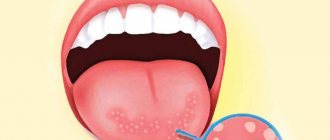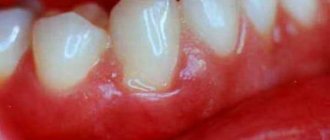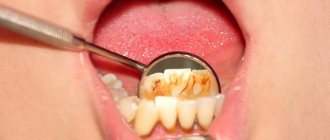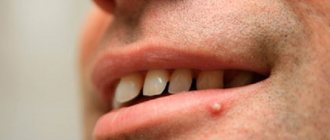The use of manganese solution for stomatitis is considered effective, since the product has a strong antimicrobial effect. Hydrocyanic acid (a harmful substance released by bacteria during stomatitis) is oxidized upon contact with potassium permanganate. Regular rinsing of the mouth with potassium permanganate can cure stomatitis. But it is important to follow safety measures, since if the crystals of the substance are poorly dissolved, a severe burn to the mucous membrane is possible.
What is stomatitis
This is a disease that affects the mucous membrane.
It can appear not only in adults, but even in children before they reach one year of age. Although most often it affects children from one to five years of age. The causative agent is an allergic reaction or an infection that leads to an inflammatory process.
Other reasons for the appearance may be the special structure of the mucous membrane or immune deficiency.
The appearance of ulcers in the mouth can lead to fever, refusal to eat, swollen lymph nodes and an unpleasant perception of taste.
What not to do with stomatitis
Often the older generation, when asked “how to treat your mouth for stomatitis?” Young mothers are advised to use alcohol solutions of brilliant green, blue, or fucorcin. It is believed that such products are good at disinfecting purulent wounds. However, this should not be done, since alcohol causes increased symptoms of inflammation and pain, which will negatively affect the child’s condition.
Another popular remedy against candidal stomatitis is borax in glycerin. The use of this product in childhood is also undesirable, since it contains quite toxic components, an overdose of which can cause significant harm to the baby’s health.
«
In the article we tried to provide the main means and methods of treating stomatitis in children. However, only a doctor can prescribe the correct treatment after examining the child. Delaying a visit to the doctor can cause serious complications and future health problems for the baby.
Types of stomatitis
- Herpetic. The mucous membrane becomes irritated and bubbles filled with liquid form. The temperature may rise, your head will feel dizzy, you will begin to shiver, or other signs of ARVI will appear;
- aphthous is accompanied by the appearance of ulcers ranging in size from five millimeters to a centimeter. A maximum of three ulcers can form on the sides of the tongue, inside the cheeks or lips;
- fungal occurs due to Condida fungus. A persistent white coating appears because breast milk promotes the growth of the fungus. Children under one year of age become ill;
- allergic. The tongue and gums turn red, there may not be a fever, but after a while this type can develop into another more serious type of disease;
- bacterial occurs during teething in children. It can also occur when causing injuries to the oral cavity. Injuries can be either mechanical or thermal. With poor hygiene, the risk of this disease is also high.
Treatment with folk remedies
Alternative treatment can be a good addition to the main therapeutic prescriptions. However, only a doctor should decide how and how much stomatitis is treated in a child.
Traditional methods are not recommended for very young children. It is better not to use them before the age of 2 in order to avoid the development of serious allergic reactions, which can only aggravate the underlying disease.
Often, beekeeping products are used in folk recipes for medicinal purposes for stomatitis: honey and propolis.
- Dissolve 2 teaspoons of natural honey in the prepared decoction of chamomile flowers (1 tablespoon per glass of boiling water). Rinse your mouth with a warm solution 3-4 times a day.
- Mix a tablespoon of fresh aloe leaves with the same amount of natural honey. Apply the resulting mixture 3 times a day to areas of inflammation using a sterile cotton swab.
- Dissolve 10 drops of propolis alcohol tincture in a full glass of warm boiled water and rinse your mouth thoroughly 3 times a day after meals.
Gargling with soda and salt has proven to be a good remedy for treating stomatitis, even in young children. To prepare the solution, you need to dissolve half a teaspoon of baking soda and salt in a glass of boiled and cooled water. Rinse your mouth 4-5 times a day, especially after eating. However, it should be remembered that it is not advisable for the soda-saline solution to come into contact with open wounds on the mucous membrane.
Traditional medicine often prescribes treating stomatitis in children with burnt alum, a powder prepared from heat-treated potassium alum. To prepare the remedy, half a teaspoon of powder is dissolved in a glass of warm water until a somewhat viscous solution is obtained. Older children can rinse their mouth with this product 3-4 times a day. For babies, you can treat the mucous membranes with a swab dipped in alum solution.
Treatment of inflammatory diseases of the oral cavity with herbs has proven itself well. For this purpose, decoctions of sage, calendula, chamomile, and oak bark are used. They have a pronounced antiseptic and astringent effect. It is recommended to rinse your mouth with such herbal decoctions at least 3-4 times a day.
Treatment of bacterial stomatitis in children
For treatment, oxolinic ointment and chlorophyllipt solution are often used.
When healing begins, the wounds are lubricated with rosehip oil, Kalanchoe juice with aloe, propolis, and so on.
Frequent rinsing with furatsilin, chamomile solution, potassium permanganate and even strong tea will help.
Prevention of stomatitis
The following are suitable preventive actions:
- Compliance with established hygiene rules;
- treat your teeth in a timely manner;
- constant washing of hands, toys, dirty objects;
- teeth cleaning;
- regularly visit your child's dentist;
- hardening;
- a diet that involves eating without sugar;
- frequent walks in the fresh air.
The main thing is to see a professional dentist and find out the type of disease, the causes, and get the most accurate recommendations for treatment.
Share:
Symptoms of the disease
The main manifestation of the disease is small painful ulcers on the oral mucosa. At the initial stage, slight redness appears, which swells slightly. Soon, at the site of redness, a shallow round ulcer with smooth edges and a thin whitish film in the middle forms. The ulcer is very painful, which interferes with eating and speaking.
Acute inflammation during stomatitis continues for several days, the ulcers heal gradually, and after healing no traces remain.
Prevention
Prevention of stomatitis in children consists of following simple rules of oral hygiene:
- when breastfeeding, the mother must keep her breast clean in order to protect the baby from infection and germs;
- brush your teeth twice a day; children under 4-5 years old should have parents help with this;
- the toothbrush should be changed regularly and be of high quality, just like toothpaste;
- it is important to teach children to wash their hands not only before eating, but also after using the toilet, walking, or any, even minor, contamination;
- visit the dentist once every six months, especially when teeth begin to change;
- fight the habit of biting your nails.
In addition to the rules of hygiene, to prevent stomatitis, it is necessary to provide the child with adequate nutrition; to strengthen the immune system, it must contain all the vitamins and other useful microelements necessary for a person. Also, you should not give him spicy food and monitor its temperature.
Important! Often stomatitis is associated with the functioning of the immune system; if there are problems, you can consult a doctor about the advisability of using vitamin complexes. For such purposes, the colloidal preparation Fo Kidz is suitable. The complex contains a complete set of nutrients consisting of natural ingredients that a child needs.
Thus, to get rid of stomatitis in children, you need to use folk or pharmacy remedies that can easily be used at home. If after 4-5 days of such treatment the result does not occur, it is necessary to use antibiotics and other radical treatments as prescribed by the doctor.
What is potassium permanganate?
The substance is a strong antiseptic that, upon contact with bacteria, destroys them. The chemical formula of potassium permanganate is KMnO4. This product comes in crystal or powder form and can be purchased at a pharmacy with a prescription. The product cannot be used in this form, as there is a high risk of burns. To treat stomatitis, you need to prepare a solution by diluting the powder in water. Depending on the concentration, the resulting liquid may be light pink or deep crimson. The drug has the following properties:
- prevents the penetration of harmful bacteria into the blood;
- has an antiseptic, bactericidal, drying, healing effect;
- eliminates the harmful effects of bacteria on the oral mucosa.
Potassium permanganate and propolis
Potassium permanganate is an affordable pharmaceutical product that can be used to rinse the mouth for stomatitis. This remedy has virtually no contraindications, except for individual intolerance, so it can be used by children of any age. In addition, the prepared rinse solution has virtually no taste or smell, which is also an advantage.
To prepare the solution, you need to mix a few crystals (usually taken by eye, about 10 pieces) with a liter of water. You can prepare the solution in advance, but preferably no more than a liter. It is recommended to rinse your mouth at least every few hours a day.
Propolis is another natural product that can be used to prepare a rinse solution for stomatitis. It has immune-strengthening, antiseptic, anti-inflammatory, antimicrobial effects. In pharmacies you can buy a ready-made water tincture, rinse your mouth with it or lubricate the affected areas with gauze 3-4 times a day.
Important! It is prohibited to use alcohol tincture of propolis to treat children, despite the fact that it is more effective.
The use of ArgoVasna Propolis chitosan gel is suitable for everyone. Silver gel stimulates cellular metabolism and activates the functional functioning of immune system cells. This promotes the speedy healing process of the mucous membrane and skin, protects against the spread of infection, and suppresses pathogenic microflora.
How to quickly relieve pain
Stomatitis can occur for various reasons; treatment must be selected based on the factor that provoked it. Most often, the disease is associated with poor oral hygiene and/or frequent consumption of food products that have aggressive properties that irritate the mucous membrane. The basic rule to get rid of redness and sores in the mouth is to exclude junk food and begin to follow the rules of hygiene.
In other cases, when stomatitis occurs due to infection, viruses, or other serious factors, a referral to specialists is required. However, it is not always possible to do this at the same time, so recipes used at home to relieve pain are useful for everyone.
Common methods that bring quick relief are:
- Ice . The simplest, most accessible remedy. The cubes must be applied directly to the places where pain is felt. This will achieve numbness, temporary “freezing” of the inflammatory process.
- Antibacterial solution . To prepare it you will need a minimum of products available in every home: salt or baking soda. Dissolve half a teaspoon of one or the other product in half a glass of water at room temperature and rinse the mouth every hour.
- Chamomile . Pharmacy infusion of chamomile consists of chemical compounds, levomenol and others, which have an analgesic effect. Based on it, a compress is made, which must be applied to the affected areas for 5-7 minutes. The procedure is repeated 3-4 times a day.
Pain from stomatitis can become very severe, so much so that it interferes with normal speech and makes it impossible to eat. Given the danger of such an inflammatory process, urgent use of medications with an analgesic effect is required. Usually their appointment is carried out after examination by a therapist, dentist, and sometimes an otolaryngologist.











